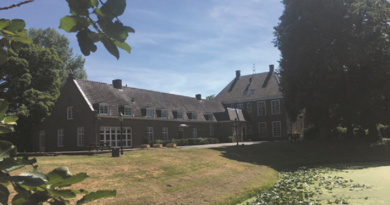125 Years of Actuarial Progression
The Royal Dutch Actuarial Association (AG)
The Royal Dutch Actuarial Association is located in Utrecht and is the professional association of actuaries and actuarial specialists in the Netherlands. AG, which celebrated its 125th anniversary last May has developed into a platform for actuaries to communicate among themselves and with society at large. The objective of AG is on the one hand to make the actuarial profession better known and appreciated and on the other hand to educate and train actuaries and actuarial specialists in terms of quality and integrity.As mentioned before, AG has around 1500 members of whom over 1000 are fully qualified actuaries and 250 are fully qualified actuarial analysts. AG also recognizes affiliate members and student members. Members of AG who are fully qualified actuaries are authorised to use the title of Actuary AG (AAG). Fully qualified actuarial analysts are authorised to use the title actuarial analyst AG.
The structure of AG is comparable to that of other associations. There is a board and there is staff (‘Bureau’). There are different committees all corresponding to different strategic topics. For example: pensions, insurance, solvency and international. Committees often have working groups who write reports on several actuarial issues.
AG does not only offer a lot of worthwhile opportunities in the Netherlands but also opportunities to be involved in an international environment. AG is a member of ’The Groupe Consultatif Européen’, which ties the actuarial associations of 37 European countries together. This European organization has a structure similar to that of AG. Dutch actuaries are able to join a European committee together with people from different countries. If this is not enough already, they can also join one of the committees of the ‘International Actuarial Association’ (IAA), the umbrella organization of actuarial associations in 84 different countries all over the world.
AG has also a close relation towards the ‘Actuarieel Instituut’ (AI). AI provides actuarial courses on different levels, but also provides Continous Permanent Development (CPD) to their members. So if someone wants to become an actuarial professional AI is the right place to go.
Managing an Association
Besides the board and different committees AG has a professional staff of which Jeroen Breen is the managing director. Jeroen did not start his career at AG, but at the Royal Dutch Naval Academy (KIM); he wanted to become a naval officer. However after a couple of years in Den Helder he decided to quit and start the study Technical Mathematics at the Technische Universiteit Eindhoven (TUE). He graduated in 1992 and continued with a year program to get his teaching certificate. At that point he did not know what being an actuary really meant and he was planning on becoming a teacher. Around that time though he visited a conference about jobs in the financial sector and this appealed to him. Jeroen: “Mathematics in itself is really theoretical, while being an actuary focuses more on the practical uses of mathematics.” This was the reason why he started working for an actuarial consultancy firm in 1993. He worked for more than 17 years in the consultancy business and made career from junior consultant to managing director before he applied for the position of managing director at AG and AI. While working in consulting, he was an active member of AG.
Jeroen lives in a small village in the south of the Netherlands. He is married and has three children. Besides his busy job, he is also chairman of the local hockey club. Jeroen admires people who are capable of making something out of nothing and people who are volunteers. He advises current econometrics students to take a serious look into becoming an actuary, because it is a broad subject and your career can take off in a lot of different interesting directions. “But above all you should do what you love most, because then your job will become your hobby.”
125 Years Anniversary
When Daniëlle and I were approaching the building of ‘Het Actuarieel Genootschap’, we immediately noticed the name of the building: Johan de Witt. We wondered who Johan de Witt could have been and thought it was a little bit arrogant of Johan de Witt to name a building after himself. Only half an hour later, we learned that Johan de Witt, besides being councillor pensionary (the political leader) of Holland (1653–1672) is in fact the first known actuary and also one of the founders of ‘De Korps Mariniers’.
Coincidentally, The Royal Dutch Navy will celebrate their 525th anniversary around the same time as the AG celebrates its 125th anniversary. And what is more, Jeroen contacted one of his former colleagues from the KIM to give a presentation about operational risks during one of the lustrum activities. However the coincidences do not stop there since this presentation was held on a Navy ship named Hr Ms Johan de Witt. During the entire year there will be different activities organized to celebrate their lustrum. Some are informal, others formal. Take for example the international congress held on May 24 in The Hague, titled: ‘Global innovation and inspiration, true colors’.
Wider Actuarial Fields
There has been an enormous shift in the field of actuarial sciences. Modern technology has changed the perspective of actuaries. Before computers and calculators existed, all calculations had to be done by hand with rulers and tables. Nowadays this aspect of the job has been simplified by computers and hence the role of the actuary has changed. Instead of just solving questions actuaries should wonder why questions are raised in the first place. “Every question is preceded by a conclusion and therefor actuaries should challenge that conclusion.” Furthermore, he believes econometrics and actuarial sciences will be more alike than they are at this moment. In the years to come actuarial science will focus on applying a filter to all the information we can get for not everything you read on the internet is true and not everything is relevant. How can we efficiently distinguish between useful and irrelevant? This is a question that has to be answered in the nearby future. Big data could be one of the solutions.
The demand for actuaries will not decline in the future. One of the reasons for this is the increasing need for transparency. Jeroen finishes by mentioning that for him the actuarial profession is the most challenging and interesting profession there is and refers to Elsevier/SEO-survey 2011 and 2012 where the actuary was ranked number 1 in most interesting jobs for starters!
Text by: Tim Gijsbers




